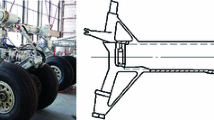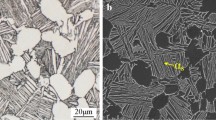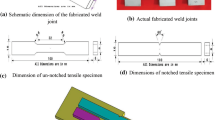Abstract
Titanium alloy threaded fasteners offer great advantages to the field of aerospace. But the use of cold rolling process when forming threaded fasteners has the disadvantages of short die life and high apparatus requirements because of poor plasticity of titanium alloy at room temperature. This paper uses a combination of axial infeed rolling process and intermediate frequency induction heating to fabricate thread with Ti6Al4V. First, the principle of hot rolling process is introduced, and then the characteristics of induction heating and the strain, displacement, and metal flow law of the thread during hot rolling process are analyzed by using finite element analysis. The influence of different forming temperatures on the rolling torque and the major diameter of the formed thread are analyzed. According to the results of finite element analysis, the best forming temperature for hot rolling process is 800 °C. Moreover, experiments are carried out on related equipment, and the experimental results are similar to the simulation results. The torque is reduced by 74% relative to that in cold rolling process. Finally, the microstructure and hardness of the formed thread are observed. A dense and directional microstructure appeared on the surface of the formed thread. The overall hardness of the thread after hot rolling is higher than that of cold rolling, and the maximum hardness of formed thread is increased by 35% relative to that of the original metal.




















Similar content being viewed by others
Availability of data and materials
Not applicable.
Code availability
Not applicable.
References
Whittaker JT, Hess DP (2015) Ductility of titanium alloy and stainless steel aerospace fasteners. J Fail Anal Prev 15:571–575
Li CH, Zhu M, Wang N, Lu XG, Cheng ST (2009) Application of titanium alloy in airplane. Chinese Journal of Rare Metals 33:84–91
Jha AK, Singh SK, Kiranmayee MS, Sreekumar K, Sinha PP (2010) Failure analysis of titanium alloy (Ti6Al4V) fastener used in aerospace application. Eng Fail Anal 17(6):1457–1465
Jin HX, Wei KX, Li JM, Peng WJ (2015) Research development of titanium alloy in the aerospace industry. Chin J Rare Metals 25(02):280–292
Murty S, Nayan N, Chakravarthy K, Sharma SC, Sinha PP (2014) Development of Ti-6Al-4V wire rods for fastener applications. Met Sci Heat Treat 56(1–2):41–44
Souza PM, Mendiguren J, Chao Q, Beladi Hodgson PD, Rolfe B (2019) A microstructural based constitutive approach for simulating hot deformation of Ti6Al4V alloy in the α+β phase region. Mater Sci Eng A
Zhang ZX, Qu SJ, Feng AH, Shen J, Chen DL (2017) Hot deformation behavior of Ti-6Al-4V alloy: effect of initial microstructure. J Alloys Compd Interdiscip J Mater Sci Solid-state Chem Phys 718:170–181
Kim JH, Lee CH, Hong JK, Kim JH, Yeom JT (2009) Effect of surface treatment on the hot forming of the high strength Ti-6Al-4V fastener. Mater Trans 50(8):2050–2056
Murty SN, Manwatkar S, Narayanan PR (2015) Microstructure control and mechanical property correlation in titanium alloy Ti-6Al-4V fasteners for space applications. Mater Sci Forum 830–831:354–357
Maciel DT, Filho SLMR, Lauro CH, Brandão LC (2015) Characteristics of machined and formed external threads in titanium alloy. Int J Adv Manuf Technol 79(5–8):779–792
Kahraman F, Gençer GM, Kahraman AD (2017) Surface nanocrystallization of SAE 1008 steel by single and multipass thread rolling process. Materialwissenschaft Und Werkstofftechnik 48(7)
Pater Z, Gontarz A, Weroñski W (2004) New method of thread rolling. J Mater Process Technol 153(1):722–728
Song JH, Lee HJ, Lee JS, Lee GA, Park J, Park SJ, Lee HW (2012) Numerical and experimental approach for incremental thread rolling process of micro-sized screws. Adv Mater Res 472–475(19):732–735
Yan H, Zhang S, Shibo MA, Liu J, Hu ZH (2017) Effect of helix angle on forming of trapezoidal threaded shaft rolled in cross wedge rolling. J Cent South Univ (Sci Technol)
Domblesky JP, Feng F (2002) A parametric study of process parameters in external thread rolling. J Mater Process Technol 121(2):341–349
Domblesky JP, Feng F (2002) Two-dimensional and three-dimensional finite element models of external thread rolling. Proc Inst Mech Eng Part B J Eng Manuf 216(4):507–517
Park SC, Dong WR, Lee KH (2018) Design of a thread rolling process for manufacturing Al6061-T6 alloy bolt using FE analysis and the Taguchi method. J Korean Soc Mar Eng
Zhang DW, Zhao SD, Wu SB, Zhang Q, Fan SQ, Li JX (2015) Phase characteristic between dies before rolling for thread and spline synchronous rolling process. Int J Adv Manuf Technol 81:513–528
Ivanov V (1998) Rolling of long screws. J Mater Process Technol
Kukielka K, Kaldunski P, Kukielka L, Kulakowska, Patyk R (2019) Prediction of the metric thread quality after axial thread rolling process on cold using of finite element methods. Computational Technologies in Engineering (TKI’2018): Proceedings of the 15th Conference on Computational Technologies in Engineering
Zhang SW, Fan SQ, Zhang P, Zhu Q, Zhao SD (2020) The formation mechanism of protrusion of long thread by axial self-infeed rolling process. Proc Inst Mech Eng Part B J Eng Manuf 234(3):095440542091207
Zhang B, Yang FL, Wang JX (2003) Fundamental aspects in vibration-assisted tapping. J Mater Process Technol 132(1):345–352
Bugay IA, Popov AY, Evdokimova OP, Nazarov PV, Datsko AI (2017) Research of thread rolling on difficult-to-cut material workpieces. J Phys Conf Ser
Hou HL, Zhao YQ, Cui MC, Zhao SD (2021) Experimental study on the axial-infeed incremental warm rolling process for spline shaft production. Int J Adv Manufa Technol 112(7–8)
Cui MC, Zhao SD, Chen C, Zhang DW, Li JX, Li YY (2018) Study on warm forming effects of the axial-pushed incremental rolling process of spline shaft with 42CrMo steel. Proc Inst Mech Eng Part E J Process Mech Eng 232:555–565
Landgrebe D, Sterzing A, Lahl M, Milbrandt TAM (2017) Hot forming of large spur gears. Procedia Eng 207:615–620
Seshacharyulu T, Medeiros SC, Morgan JT, Malas JC, Frazier WG, Prasad Y (2000) Hot deformation and microstructural damage mechanisms in extra-low interstitial (ELI) grade Ti-6Al-4V. Mater Sci Eng A 279(1–2):289–299
Lin YC, Chen XM (2011) A critical review of experimental results and constitutive descriptions for metals and alloys in hot working. Mater Des 32(4):1733–1759
Zhu FH, Xiong W, Li XF, Chen J (2017) A new flow stress model based on Arrhenius equation to track hardening and softening behaviors of Ti6Al4V alloy. Rare Metals
Kesangam N, Pinitsoontorn S, Srimanosaowapak S (2018) Effect of initial microstructure on induction heating of A319 aluminium alloy. Mater Today Proc 5(3):9615–9623
Masete S, Mutombo K, Siyasiya C, Stumpf W (2015) Effect of ageing treatment on the microstructure and hardness of the Ti6Al4V alloy. Mater Sci Forum 828–829(4):194–199
Carvalho AOD, Brandão CL, Panzera TH, Lauro CH (2012) Analysis of form threads using fluteless taps in cast magnesium alloy (AM60). J Mater Process Tech 212(8):1753–1760
Funding
This work was supported by the Joint Fund for Aerospace Advanced Manufacturing Technology Research Key Program (grant no.U1937203).
Author information
Authors and Affiliations
Contributions
Jiang Fei analyzed, researched, and wrote this paper; Shuowen Zhang and Jinzhou Gao analyzed, researched, and polished the paper; Shengdun Zhao supervised the paper; Hong Jiang and Liangyu Fei assisted with the experiment. All authors read and approved the final manuscript.
Corresponding author
Ethics declarations
Ethics approval
Not applicable.
Consent to participate
All the authors participated in this research.
Consent for publication
All the authors approved the final manuscript for publication.
Competing interests
The authors declare no competing interests.
Additional information
Publisher's note
Springer Nature remains neutral with regard to jurisdictional claims in published maps and institutional affiliations.
Rights and permissions
About this article
Cite this article
Jiang, F., Zhao, S., Zhang, S. et al. Finite element analysis and experiment study on axial infeed hot rolling process of thread with Ti6Al4V. Int J Adv Manuf Technol 121, 5873–5884 (2022). https://doi.org/10.1007/s00170-022-09615-0
Received:
Accepted:
Published:
Issue Date:
DOI: https://doi.org/10.1007/s00170-022-09615-0




